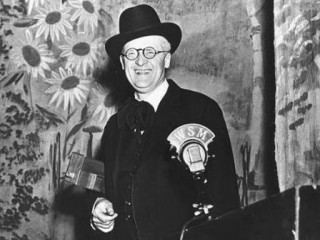
George D. Hay biography
Date of birth : 1895-11-09
Date of death : 1968-05-08
Birthplace : Attica, Indiana,U.S.
Nationality : American
Category : Famous Figures
Last modified : 2011-11-29
Credited as : radio personality, Grand Ole Opry radio program, "Solemn Ol' Judge"
0 votes so far
George Hay never sang a single song or plucked a single tune, but he exerted an immense influence on the development of country music as an entertainment form. Hay was the founder of the "Grand Ole Opry," the informal showcase of country and western talent that has become the industry's signature program. Listeners across America were introduced to country music by way of powerful WSM Radio in Nashville; the show survives to this day on its parent station and in syndication. Hay, who called himself the "Solemn Ol' Judge," saw radio as an important medium for the popularization of rural music. Although his Opry became increasingly glamorous and professional over the years, it has never lost the intimate "barn dance" quality he sought to preserve.
George Dewey Hay was born in Attica, Indiana, in 1895. In his early twenties he moved south to Memphis, Tennessee, where he gained a job as a reporter for the Memphis Commercial Appeal. When the newspaper branched out into commercial radio, Hay switched formats, serving as an editor and an announcer. By 1924 he was being heard over the air on WLS in Chicago, a station that reached listeners throughout the South and Midwest. WLS hired Hay to serve as master of ceremonies for a show of hillbilly music modeled on the old-fashioned barn dances so popular in all of America's rural regions. Hay had been strongly influenced by hoedowns he had attended in the Ozark Mountains and elsewhere, and he strove to re-create that exciting, informal atmosphere in the studio.
The "WLS Barn Dance," soon renamed the "National Barn Dance," was an immediate success, and Hay found himself named top radio announcer of 1924 in a Radio Digest poll. In Country Music U.S.A., Bill C. Malone notes that Hay, "calling himself the 'Solemn Ol' Judge,' and blowing blasts from a steamboat whistle,...helped to give the new Barn Dance show an authentic, homey atmosphere." The "National Barn Dance" featured stringbands, fiddlers, square-dance callers, other country performers, as well as more mainstream crooners and balladeers. It too enjoyed a long run on WLS and later WGN in Chicago, finally going off the air in 1968.
Late in 1925, Hay moved to WSM, a new station in Nashville, Tennessee. Although WSM had only a seventy-five-mile range, Hay found the offer attractive because he was named director of the station. His employers, National Life and Accident Insurance Company, had rather high-brow aspirations, but Hay asserted himself and found air time for another barn dance show. The original "WSM Barn Dance" had its debut November 28, 1925, with Hay as master of ceremonies, and a fiddler, eighty-year-old Uncle Jimmy Thompson, as the sole performer. Within weeks the station was deluged with local bands who wanted air time; Hay obliged them, sometimes giving them down-home names such as the Possum Hunters, the Clod Hoppers, and the Fruit Jar Drinkers.
Much of WSM's programming came from an NBC affiliate in New York City. Therefore Hay found his show following a long stretch of classical music and grand opera. One night Hay opened his barn dance by announcing: "Folks, you've been up in the clouds with grand opera; now get down to earth with us in a...shindig of Grand Ole Opry!" The name stuck, and by 1926 the barn dance was formally known as the Grand Ole Opry.
Soon the Opry was expanded to three hours in length. Performers were paid very little for appearances, but the honor of a Grand Ole Opry gig could lead to invitations for tours and bigger public performances. Hay never found himself at a loss for talent. In 1932 WSM expanded to 50,000 watts, bringing the station a listening area that included all of the eastern United States, the Midwest, and parts of Canada. The Grand Ole Opry's influence grew accordingly, and many of its stars went on to national fame. Such artists as Roy Acuff, Eddy Arnold, Ernest Tubb, Uncle Dave Macon, Minnie Pearl, and Bill Monroe found their careers boost ed by regular Opry appearances, and by the 1950s a stint on the Opry was an absolute prerequisite to fame in the country format.
Malone writes: "In the years that followed, Hay introduced the show each Saturday night with his steamboat whistle and his warm command, 'Let her go, boys'...But the mood of spontaneous simplicity could not last, because the barn dances had demonstrated that country music could sell. Judge Hay lived long enough to see his 'down-to-earth' show become a national institution and the longest-lasting program on American radio. The popularity of the Grand Ole Opry and other barn dance shows presaged country music's coming commercial success--and its incorporation into the American popular culture mainstream."
Hay retired from the Grand Ole Opry in 1956 and spent the rest of his life living quietly with his daughter in Virginia. In 1966 he returned to Nashville one last time for his induction into the Country Music Hall of Fame. His death at home on May 9, 1968, was first announced on WSM, in honor of his pioneering work there. The Grand Ole Opry now originates from its own theatre at Opryland Park in Nashville. It is still heard over the air on Saturday nights and still follows the format Hay initiated--each artist plays for fifteen or twenty minutes in front of a live audience, in an atmosphere both intimate and informal. The long tenure of the Grand Ole Opry--sixty years and counting--would no doubt please the Solemn Ol' Judge.
















